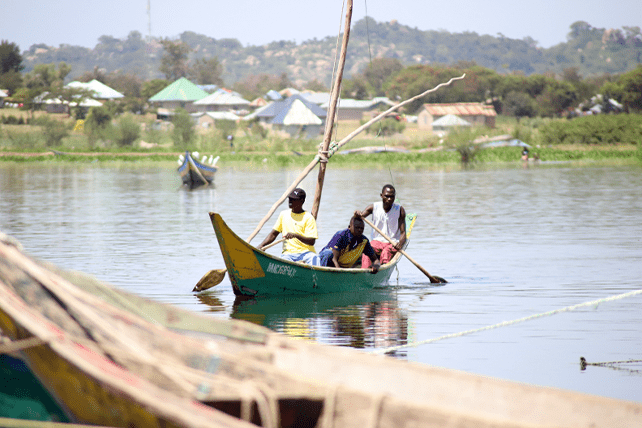The Church of Christ, a concrete structure with wooden pews and stained-glass windows in Budalang’i, now sits half-sunken in marshland. Its bell tower is partly still visible from a distance.

Women in Budalang’i, Kenya, who have been displaced by unpredictable water levels in Lake Victoria. (Photo by Tonny Onyulo)
“We had baptisms here. We buried our elders here. This was our sanctuary,” said Mary Anyango, 58, a longtime congregant who now worships with her neighbors under a mango tree. “Now, it feels like God is further away.”
Like Anyango, across the region, churches and congregants are adapting in creative and resilient ways. Services have been held in classrooms, tents, market stalls and even boats. Pastors have converted living rooms into altars, where worshippers sit on mats or plastic chairs as chickens cluck in the background.
One Sunday in June, more than 80 people gathered under a thatched shelter in Bunyala village, also in Busia County, to pray and sing.
“This is what church means now — people, not buildings,” said Pastor John Musumba, who leads a Pentecostal community that lost its church to flooding in 2022. “The gospel doesn’t need walls. It needs hearts.”
Still, religious leaders say attendance has dropped. Some elderly members have stopped coming to church entirely, fearing the floods or unable to walk through the mud. Tithes have declined, and efforts to rebuild are stalled by poverty and uncertainty, they said.

Pastor John Musumba in Kenya near Lake Victoria. (Photo by Tonny Onyulo)
For many congregations, efforts to rebuild have been slow or symbolic. Some have erected temporary churches on higher ground with salvaged wood and tarpaulin. Others are fundraising to purchase plots farther away from the flood zone, but many cannot afford to do so.
“We are competing with families who need land for shelter,” said catechist Vincent Okumu, who coordinates emergency aid for displaced families with a local ecumenical relief committee. “Everyone is trying to move uphill. There is not enough space.”
But faith remains a source of strength and solidarity. Congregants said the loss of physical buildings has not shaken their belief in divine presence, but in some cases has deepened it.
“In this crisis, we have learned that God is not confined to concrete,” said Patrick Okumu, a lay local preacher who now holds weekly Bible studies under a baobab tree. “He is with us in the mud, in the storm, in the rebuilding.”
Still, many hope the outside world will take action.
“This is not just about Kenya,” Khamala said. “This is about how climate change is eroding not only coastlines and crops, but culture, heritage and spiritual life. These churches are the canaries in the coal mine.”
Back at the waterlogged remains of Free Pentecostal Fellowship in Kenya on a recent Sunday, Ogutu led his congregation in a song of lamentation.
“Lord, do not pass us by, even when the waters rise,” they sang in Luhya, as children clapped along and elders wiped away tears.
This article originally appeared here.

